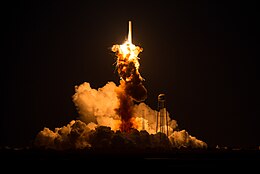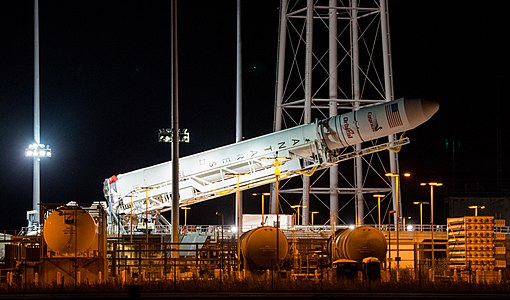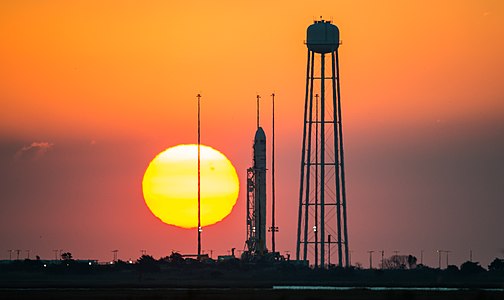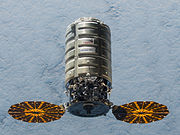 One of the Antares 130's AJ26 engines ruptures, fifteen seconds into the flight. One of the Antares 130's AJ26 engines ruptures, fifteen seconds into the flight. | |
| Names | CRS Orb-3 |
|---|---|
| Mission type | ISS resupply |
| Operator | Orbital Sciences Corporation |
| Mission duration |
|
| Spacecraft properties | |
| Spacecraft | S.S. Deke Slayton |
| Spacecraft type | Standard Cygnus |
| Manufacturer |
|
| Launch mass | 7,594 kg (16,742 lb) |
| Payload mass | 2,215 kg (4,883 lb) |
| Start of mission | |
| Launch date | 28 October 2014, 22:22:38 (28 October 2014, 22:22:38) UTC (6:22:38 pm EDT) |
| Rocket | Antares 130 |
| Launch site | MARS, Pad 0A |
| End of mission | |
| Disposal | Flight termination |
| Destroyed | 28 October 2014, 22:23:01 (28 October 2014, 22:23:01) UTC |
 NASA insignia Commercial Resupply Services← SpaceX CRS-4SpaceX CRS-5 → Cygnus flights← Orbital-2OA-4 → | |
Orbital-3, also known as Orb-3, was an attempted flight of Cygnus, an automated cargo spacecraft developed by United States–based company Orbital Sciences, on 28 October 2014. The mission was intended to launch at 22:22:38 UTC that evening. This flight, which would have been its fourth to the International Space Station and the fifth of an Antares launch vehicle, resulted in the Antares rocket exploding seconds after liftoff.
Spacecraft
Main article: Cygnus (spacecraft)
This would have been the third of eight flights by Orbital Sciences under the Commercial Resupply Services (CRS-1) contract with NASA. This was the first attempted flight of the Antares 130, which uses a more powerful Castor 30XL second stage, and the last flight of the standard-sized Cygnus Pressurized Cargo Module.
In an Orbital Sciences tradition, this Cygnus spacecraft was named S.S. Deke Slayton after one of NASA's original Mercury Seven astronauts and Director of Flight Operations, who died in 1993. As the launch failed, the next spacecraft was also named after Deke Slayton.
Launch and early operations
| Attempt | Planned | Result | Turnaround | Reason | Decision point | Weather go (%) | Notes |
|---|---|---|---|---|---|---|---|
| 1 | 27 Oct 2014, 6:45:00 pm | Scrubbed | — | Other | A sailboat entered the range safety zone. | ||
| 2 | 28 Oct 2014, 6:22:38 pm | Failure | 0 days 23 hours 38 minutes | Technical | 28 Oct 2014, 6:23 pm | A LOX turbopump failure in the first stage engine caused the rocket to fall back onto the pad, but was destroyed by range safety. |
The mission was scheduled to launch on 27 October 2014 at 22:45 UTC from the Mid-Atlantic Regional Spaceport at the Wallops Flight Facility in Wallops Island, Virginia, with rendezvous and berthing with the ISS early in the morning on 2 November 2014. This was the first night-time launch for both the Antares launcher and Cygnus spacecraft. The launch was scrubbed due to safety concerns of a sailboat entering the exclusion zone less than ten minutes before launch. A 24-hour delay was put in place, with the next launch opportunity scheduled for 22:22:38 UTC on 28 October 2014.
Launch failure
The Antares rocket carrying the Orb-3 Cygnus launched as scheduled from Launch Pad 0A on 28 October 2014. Fifteen seconds after liftoff a failure of propulsion occurred in the first stage. The vehicle began falling back to the launch pad and the Range Safety Officer engaged its flight termination system just before impact.
The resulting explosion was felt in Pocomoke City, Maryland, 20 mi (32 km) away. The fire at the site was quickly contained and allowed to burn itself out overnight. Initial review of telemetry data found no abnormalities in the pre-launch, the launch sequence, and the flight, until the time of the failure.
In a press release, NASA stated that there were no known issues prior to launch and that no personnel were injured or missing but that the entire payload was lost and there was significant damage to the launch pad. On 29 October 2014, teams of investigators began examining debris at the crash site, while a survey the same day found that there was no serious damage to the launch pad and site fuel tanks, although repairs would be required.
Subsequent investigation found that the LOX turbopump had exploded, which in turn, caused a shock wave that severed surrounding propellant lines and started a fire from leaking fuel. The fire damaged various components in the thrust section leading to the engines gradually being shut down, although a specific reason for the failure could not be determined. Possible causes were a defective pump bearing, ingestion of loose debris, or a manufacturing defect.
Payload
Orb-3 carried a variety of NASA-manifested payloads, some determined fairly late in the days before the launch. The Cygnus cargo vehicle carried 2,215 kg (4,883 lb) of supplies and experiments meant for the International Space Station. It included some CubeSats to be launched from the International Space Station.
Flock-1d
Planet Labs was launching Flock-1d, its next flock of 26 Earth observation nanosatellites. After the accident they stated that this would not set them back due to their approach to space involving many satellites in various constellations.
Arkyd-3
Arkyd-3 was a 3U CubeSat technology demonstrator from private company Planetary Resources (PRI). PRI had packaged a number of the non-optical satellite technologies of its larger Arkyd-100 telescope satellite—essentially the entire base of the Arkyd-100 satellite model revealed in January 2013, but without the space telescope—into a "cost-effective box" of Arkyd 3, or A3, for early in-space flight testing as a subscale nanosatellite. The Arkyd-3 testbed satellite was packaged as a 3U CubeSat form-factor of 10×10×30 centimetres (3.9×3.9×11.8 in). PRI contracted with NanoRacks to take the A3 to the ISS where it was planned to be released from the airlock in the Kibō module.
The subsystems to be tested included the avionics, attitude determination and control system (both sensors and actuators), and integrated propulsion system that will enable proximity operations for the Arkyd line of prospectors in the future.
This near-term attempt to validate and mature the Planetary Resources satellite technology was planned to launch in October 2014, before launch and flight test of the Arkyd-100 in 2015.
Other payloads
CRS Orb-3 was carrying eighteen student experiments designed to investigate crystal formation, seed germination, plant growth, and other processes in microgravity as part of the Student Spaceflight Experiments Program (SSEP). It also carried the first open source ArduLab-powered student experiments.
Two amateur radio CubeSats, RACE and GOMX-2, were on board, among other satellites. On board GOMX-2 were two payloads. One payload was a pathfinder experiment for the Small Photon-Entangling Quantum System. designed by the Centre for Quantum Technologies. The other was a sail brake experiment to remove a CubeSat from orbit by increasing aerodynamic drag.
Failure analysis and aftermath
With some preliminary investigation completed, Orbital cited the cause of the Orb-3 launch failure as likely being a turbopump failure in one of the Aerojet Rocketdyne AJ-26 engines, a refurbished Russian NK-33 engine. A NASA report from the failure investigation was released in October 2015. Although NASA and Orbital Sciences agree that the turbopump failed, they differ as to the root cause (machining or debris).
By January 2015, repairs to the Wallops Flight Facility began; they were completed in the fall of 2016. To meet its Commercial Resupply Services obligations with NASA, Orbital Sciences launched two Enhanced Cygnus cargo spacecraft via Atlas V launch vehicle—CRS OA-4 (Deke Slayton II) in December 2015 and CRS OA-6 (Rick Husband) in March 2016—while a new engine was selected and tested for the Antares launch vehicle. Orbital Sciences had been conducting an evaluation and review of an AJ-26 replacement engine prior to the incident, and in the year following the explosion they selected the NPO Energomash RD-181, the export version of the RD-191, to replace the AJ-26 on Antares. The Russians selected this same engine (RD-193), to replace the NK-33 engine used on Soyuz-2. The redesigned Antares launch vehicle flew again in 2016.
Manifest
Total cargo: 2,215 kg (4,883 lb)
- Science investigations: 727 kg (1,603 lb)
- U.S. science: 569 kg (1,254 lb)
- International partner science: 158 kg (348 lb)
- Crew supplies: 748 kg (1,649 lb)
- Equipment: 124 kg (273 lb)
- Food: 617 kg (1,360 lb)
- Flight procedure books: 7 kg (15 lb)
- Vehicle hardware: 635.7 kg (1,401 lb)
- U.S. hardware: 605.7 kg (1,335 lb)
- JAXA hardware: 30 kg (66 lb)
- Spacewalk equipment: 66 kg (146 lb)
- Computer resources: 37 kg (82 lb)
- Command & data handling equipment: 34 kg (75 lb)
- Photography/TV equipment: 3 kg (6.6 lb)
Total cargo with packing material: 2,294 kilograms (5,057 lb)
Gallery
-
 Integration of payload fairing on Antares rocket
Integration of payload fairing on Antares rocket
-
 Rollout of Antares to launch pad
Rollout of Antares to launch pad
-
 Antares being raised at pad.
Antares being raised at pad.
-
 Antares vertical at pad
Antares vertical at pad
-
 Against the disk of the rising Sun on launch day
Against the disk of the rising Sun on launch day
-
 Explosion of Antares after crashing.
Explosion of Antares after crashing.
-
 Aftermath of explosion
Aftermath of explosion
See also
- VSS Enterprise crash, which occurred a few days after the Orb-3 crash
- SpaceX CRS-7, another Commercial Resupply Service mission that experienced a launch failure
References
- ^ Bergin, Chris (22 February 2012). "Space industry giants Orbital upbeat ahead of Antares debut". NasaSpaceflight. Retrieved 29 March 2012.
- Todd, David (28 October 2014). "Antares 130 launch fails in explosion destroying Cygnus cargo craft and damaging launch pad (Updated)". Seradata.
- ^ "Orbital CRS-3 Mission to the International Space Station: Media Press Kit" (PDF) (Press release). NASA. October 2014. Retrieved 2 September 2018.
 This article incorporates text from this source, which is in the public domain.
This article incorporates text from this source, which is in the public domain.
- "Cygnus Orb-3 Launch Failure". Spaceflight 101. 28 October 2014. Archived from the original on 4 March 2016. Retrieved 6 January 2016.
- ^ "First Nighttime Launch of the Antares Rocket Scheduled October 27 From Wallops". NASA. Orbital Sciences. 22 October 2014. Retrieved 24 October 2014.
 This article incorporates text from this source, which is in the public domain.
This article incorporates text from this source, which is in the public domain.
- "Worldwide Launch Schedule". Spaceflight Now. Archived from the original on 11 September 2013. Retrieved 26 September 2014.
- "International Space Station Flight Schedule". SEDS. 15 May 2013.
- ^ Plait, Phil (28 October 2014). "Breaking: Antares Rocket Explodes On Takeoff". Slate. Retrieved 28 October 2014.
- "ISS Commercial Resupply Services Mission (Orb-3): 22 October 2014". Orbital Sciences. 22 October 2014. Archived from the original on 25 October 2014. Retrieved 24 October 2014.
- ^ "Orb-3 Mission Updates". Orbital Sciences.
- Clark, Stephen (31 October 2014). "First stage propulsion system is early focus of Antares investigation". Spaceflight Now.
- Vaughn, Carol (29 October 2014). "Explosion witness: "It looked like an atomic bomb"". Delmarva Daily Times.
- "Unmanned NASA-contracted rocket explodes over eastern Virginia". CNN. 29 October 2014. Retrieved 29 October 2014.
- "NASA, Orbital CRS-3 Press Conference Scheduled". NASA. Retrieved 29 October 2014.
 This article incorporates text from this source, which is in the public domain.
This article incorporates text from this source, which is in the public domain.
- Wall, Mike (28 October 2014). "Private Orbital Sciences Rocket Explodes During Launch, NASA Cargo Lost". SPACE.com. Retrieved 28 October 2014.
- "Teams investigate failure of unmanned rocket off Virginia coast". CNN. 29 October 2014. Retrieved 29 October 2014.
- Clark, Stephen (31 October 2014). "Initial damage assessment shows Antares pad intact". Spaceflight Now. Retrieved 13 March 2016.
- "NASA Independent Review Team: Orb–3 Accident Investigation Report, Executive Summary" (PDF). NASA. 9 October 2015.
 This article incorporates text from this source, which is in the public domain.
This article incorporates text from this source, which is in the public domain.
- "Flock-1a, −1b, −1c, −1d, −1e". Skyrocket.de. Retrieved 29 October 2014.
- "Space is hard: Antares rocket failure". Planet.com. Retrieved 29 October 2014.
- Heater, Bryan (21 January 2013). "Planetary Resources shows off Arkyd-100 prototype, gives a tour of its workspace". Engadget. Retrieved 23 January 2013.
- ^ Wall, Mike (24 April 2013). "Private Asteroid-Mining Project Launching Tiny Satellites in 2014". Space.com. Retrieved 25 April 2013.
- Romano, Benjamin (26 June 2013). "Planetary Resources Inks 3D Systems Deal, Plans Test Launch From ISS". Xconomy. Retrieved 18 May 2014.
- Lewicki, Chris; Voorhees, Chris; Anunsen, Spencer (24 April 2013). "Planetary Resources One-year Update". YouTube.com. Retrieved 2 May 2013.
- Wilhelm, Steve (16 October 2014). "First step toward asteroid mining: Planetary Resources set to launch test satellite". Puget Sound Business Journal. Retrieved 19 October 2014.
- "Cygnus Orb-3 Cargo Manifest". Spaceflight 101. Archived from the original on 11 January 2015.
- "NanoRacks-Duchesne-Algae Production in Microgravity with Variable Wavelengths of Light". NASA. 24 September 2015. Retrieved 21 December 2015.
 This article incorporates text from this source, which is in the public domain.
This article incorporates text from this source, which is in the public domain.
- Ling, Alexander "Alexander Ling's Team Webpage"
- "CQT | Centre for Quantum Technologies". www.quantumlah.org.
- Djursing, Thomas (30 October 2014). "Aalborg-forskers patenterede rumopfindelse gik tabt i raket-eksplosion". Ingeniøren. Archived from the original on 31 October 2014. Retrieved 30 October 2014.
- Rhian, Jason (18 November 2014). "NASA Details Orbital's Requirements to Meet CRS Contract". Spaceflight Insider. Retrieved 15 January 2015.
- "NASA Independent Review Team: Orb–3 Accident Investigation Report, Executive Summary" (PDF). NASA. 9 October 2015. Retrieved 7 December 2015.
 This article incorporates text from this source, which is in the public domain.
This article incorporates text from this source, which is in the public domain.
- Foust, Jeff (29 October 2015). "NASA, Orbital Differ on Root Cause of Antares Launch Failure". Space News. Retrieved 30 October 2015.
- Bergin, Chris (8 December 2014). "Return to Wallops Flight Facility". NasaSpaceflight. Retrieved 15 January 2015.
- Bergin, Chris (5 November 2014). "Post mortem for CRS-3 Antares notes turbopump failure". NasaSpaceflight. Retrieved 15 January 2015.
- Gebhardt, Chris (14 August 2015). "Orbital ATK make progress toward Return To Flight of Antares rocket". NasaSpaceflight. Retrieved 23 August 2015.
- "Orbital CRS-3 Mission Overview" (PDF). NASA. October 2014. Retrieved 24 October 2014.
 This article incorporates text from this source, which is in the public domain.
This article incorporates text from this source, which is in the public domain.
External links
- Cygnus Orb-3 at orbital.com
- Cygnus Orb-3 press kit at nasa.gov
- Cygnus Orb-3 launch failure on YouTube
- NASA post-launch press conference on YouTube
| Cygnus spacecraft | ||
|---|---|---|
| Launch vehicles |  | |
| Operators | ||
| Past missions |
| |
| Current missions |
| |
| Future missions | ||
| ||
| Uncrewed spaceflights to the International Space Station | ||
|---|---|---|
| ||
| 2000–2004 |  | |
| 2005–2009 | ||
| 2010–2014 | ||
| 2015–2019 | ||
| 2020–2024 | ||
| Future | ||
| Spacecraft | ||
| ||